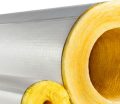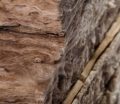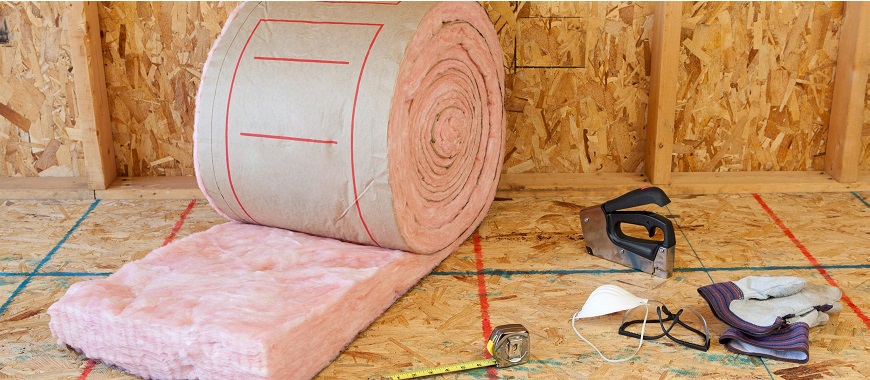
Fiberglass insulation for crawl spaces plays a crucial role in enhancing energy efficiency and maintaining home comfort. Proper insulation in crawl spaces helps in controlling temperature fluctuations and reducing energy bills by creating a barrier against heat loss or gain. Choosing the right insulation is essential, as it affects not only the thermal performance but also the overall health of the home environment. Fiberglass insulation for crawl spaces is a popular option due to its cost-effectiveness and ease of installation. It is known for its good thermal performance, which helps to keep the living areas above comfortable. However, it’s important to ensure proper installation to avoid potential issues such as moisture accumulation and mold growth. Fiberglass insulation for crawl space, installed between floor joists, is affordable, offers effective heat and noise control, but is best suited for well-ventilated areas.
Simplifying Your Life: Key Functionalities
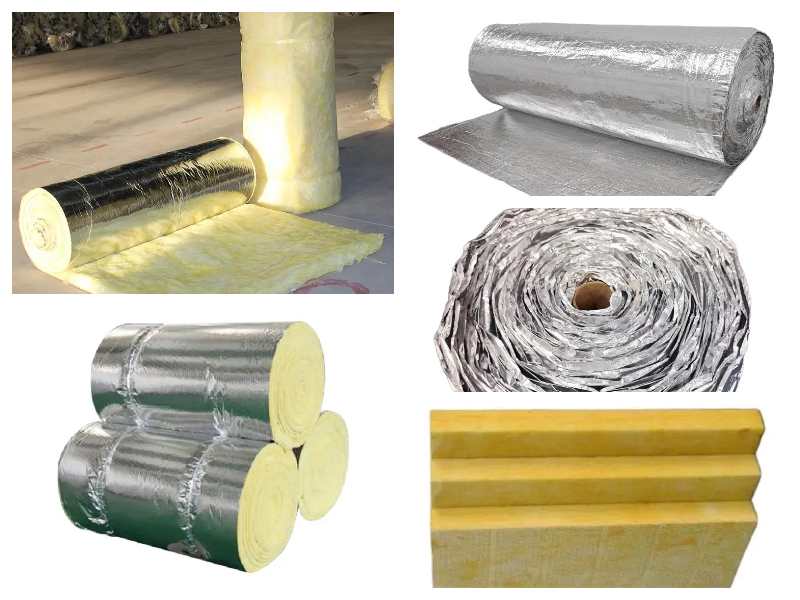
| Attributes | Details |
|---|---|
| After-sales service | Online Technical Support, Free Spare Parts, Return and Replacement, Other |
| Project solving ability | Graphic Design, Overall Project Solution, Cross-Category Integration |
| Origin | Hebei, China |
| Brand name | GangLong Fiberglass |
| Type | Glass Wool Insulation / Glass Fiber Cloth |
| Material | Glass Wool / Aluminum Foil / Glass Fiber |
| Reflectivity | 95%-99% (Astm E903) |
| Thermal conductivity | 0.038 W/M2 |
| Application | Metal Building Insulation |
| Facing | Fsk, Aluminum Foil. |
| Flammability grade | Class O / Class A1 |
| Function | Insulation Material |
| Thickness | Customized |
| Length | Customized |
| Width | Customized |
| Features | Environmentally Friendly |
| Certificate | CE ISO FM CCS |
| Application | Building Insulation |
| Transportation method | Shipping |
The Importance of Fiberglass Insulation for Crawl Space Ceilings
Insulating crawl space ceilings is a crucial aspect of home energy efficiency. Proper insulation in these areas can significantly impact overall heating and cooling costs by preventing energy loss. Fiberglass insulation for crawl space ceilings provides a reliable barrier against heat transfer, helping to maintain stable temperatures in the rooms above. This is particularly important in homes with unconditioned crawl spaces, where inadequate insulation can lead to higher energy bills and discomfort. By choosing the right type of insulation and installing it correctly, homeowners can improve both the efficiency and comfort of their living spaces.
Best Practices for Insulating Crawl Space Ceilings
When it comes to insulating crawl space ceilings, several best practices should be followed to ensure optimal performance and longevity of the insulation. First and foremost, proper installation is key. Fiberglass insulation for crawl space ceilings should be installed between the floor joists, with the insulation batts or rolls fitting snugly without gaps. Gaps or compressed areas can significantly reduce the effectiveness of the insulation, allowing heat to escape or enter.
Before installation, it’s essential to prepare the crawl space properly. This involves sealing any gaps or cracks in the foundation walls and ensuring that the area is dry and free from mold or moisture. Moisture can reduce the effectiveness of fiberglass insulation and lead to mold growth, which can compromise both the insulation and the overall health of the home. To mitigate these issues, molded fiberglass insulation is an excellent option, as it is designed to provide enhanced moisture resistance. This type of insulation not only helps maintain thermal efficiency but also minimizes the risk of mold development, ensuring a healthier indoor environment.
Additionally, using a vapor barrier can help prevent moisture from reaching the insulation. A vapor barrier is typically installed on the ground of the crawl space and acts as a shield against moisture that can otherwise degrade the insulation. GangLong Fiberglass offers high-quality fiberglass insulation products designed specifically for crawl spaces, ensuring that you have the right materials for effective insulation.
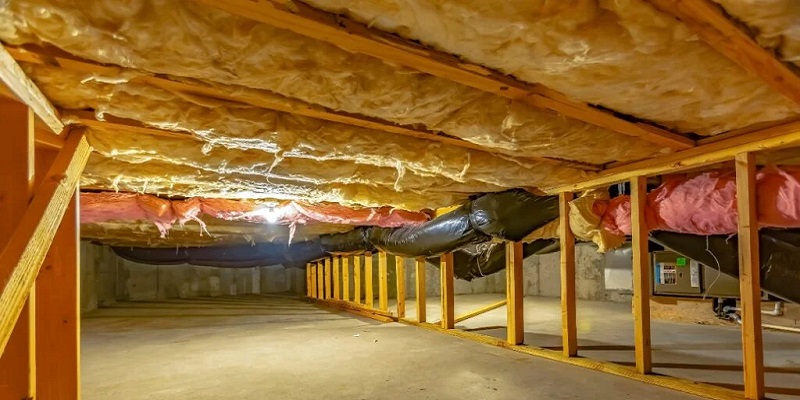
Crawl Spaces: Definition and Types
A crawl space is a shallow area beneath a home, located between the ground and the first-floor joists. It provides access to plumbing, electrical systems, and structural components. Unlike basements, crawl spaces are not fully insulated by being underground and therefore require additional insulation to enhance energy efficiency and prevent moisture issues. These spaces vary in size, with some allowing only enough room to crawl, while others may be deep enough to squat or stand.
Crawl spaces are classified into two types:
Ventilated Crawl Spaces
These spaces feature intentional airflow to remove moisture year-round, reducing the risk of mold and standing water. However, they can experience temperature extremes, requiring insulation to prevent drafts from rising through the floor.
Unventilated Crawl Spaces
Also known as enclosed crawl spaces, these are sealed from outside air, providing better control over humidity and temperature. While less prone to temperature swings, they require moisture-resistant insulation and may benefit from wall insulation to prevent drafts.
The Benefits of Insulating a Crawl Space
Insulating your crawl space offers a range of benefits that can improve your home’s energy efficiency, comfort, and structural integrity.
Enhanced Energy Efficiency
By insulating the crawl space, you create a thermal barrier that reduces energy loss through the floor. This helps maintain consistent indoor temperatures, reducing the workload on your heating and cooling systems.
Lower Heating and Cooling Costs
With improved energy efficiency, you can significantly lower your monthly utility bills. Insulation prevents heat loss in the winter and keeps cool air inside during the summer, ensuring your HVAC system operates more efficiently.
Prevention of Frozen Pipes
Crawl space insulation protects plumbing lines from freezing in cold weather, which can save you from costly repairs and potential water damage.
Mold and Moisture Control
A properly insulated crawl space helps control moisture levels, reducing the risk of mold growth and protecting your home’s infrastructure from damage caused by condensation or standing water.
Increased Comfort
Insulation eliminates drafts and cold floors, making your living space more comfortable year-round. It also contributes to better indoor air quality by reducing allergens and moisture infiltration.
How to Determine If Your Crawl Space Needs Insulation
Knowing when to insulate or upgrade the insulation in your crawl space is crucial to maintaining a healthy and efficient home. Here’s how to identify the need for insulation:
Common Signs Your Crawl Space Needs Attention
Pay attention to signs such as cold floors, rising energy bills, warped flooring, or persistent allergies. These symptoms may indicate insufficient or damaged insulation, as well as underlying moisture or air leakage problems.
Inspecting Your Crawl Space
To assess the condition of your crawl space, follow these steps:
- Gear Up for Safety: Wear an N-95 mask to protect yourself from mold spores and dust.
- Enter the Crawl Space: Use the access door to safely enter the area.
- Assess Ventilation: Determine if the crawl space is ventilated or sealed, as this will influence insulation needs.
- Check for Issues: Look for standing water, musty odors, visible black mold, or damaged insulation. Inspect the floor joists for signs of rot, warping, or weakness. Additionally, examine the foundation walls for high water marks that indicate water damage.
By identifying these issues, you can determine whether your crawl space requires insulation and take appropriate steps to improve its condition.
Subsequent Considerations for Installing Fiberglass Insulation for Crawl Space
Proper installation and maintenance of fiberglass insulation in a crawl space are essential to maximize its benefits and ensure longevity. Below are key considerations divided into three parts:
Regular Maintenance for Long-Term Efficiency
Maintaining your crawl space insulation is critical to preserving energy efficiency and protecting your home’s infrastructure. Inspect the space annually for signs of moisture, pest intrusion, or insulation damage. Check vents (if present) to ensure they remain free of debris, and monitor indoor humidity levels to prevent condensation that can degrade fiberglass. Regular upkeep will help maintain the benefits of the insulation and reduce the risk of costly repairs.
Importance of Moisture Control
Moisture is one of the biggest threats to fiberglass insulation in crawl spaces. Without proper moisture management, insulation can lose its effectiveness and promote mold growth. To address this, install a quality vapor barrier over the ground and extend it to the foundation walls to block moisture from the soil. Seal air leaks and consider closing vents if your crawl space is unventilated. These steps ensure the insulation remains dry and effective for years.
Additional Installation and Safety Tips
When insulating a crawl space, plan for lighting and accessibility to simplify maintenance inspections. Use protective gear during installation to avoid irritation or inhaling fibers. Invest in high-quality tools for precise cutting and fitting of fiberglass batts. For homes in radon-prone areas, incorporate a radon mitigation barrier alongside insulation to enhance safety. Finally, document all installation details, including materials and dates, for future reference during renovations or home sales.
By following these steps, fiberglass insulation in crawl spaces can provide lasting thermal performance, improved energy efficiency, and a healthier living environment.
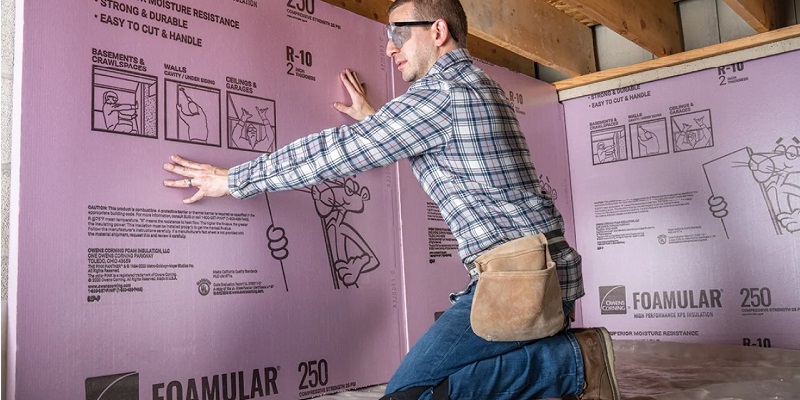
Installation Methods for Fiberglass Insulation in Crawl Spaces
There are various methods for installing fiberglass insulation in crawl space ceilings, each with its own set of considerations. One common method is the use of fiberglass batts or rolls, which are cut to fit between the floor joists. These batts are held in place by friction or by using insulation supports or fasteners. It’s crucial to ensure that the insulation is evenly distributed and fills the entire cavity to prevent thermal bridging, where heat can bypass the insulation through gaps or uneven areas.
Another method involves the use of fiberglass blankets or batts with a vapor barrier attached. These products offer dual benefits by providing insulation while also serving as a moisture barrier. When installing these products, make sure that the vapor barrier side faces the crawl space, and overlap any seams to ensure complete coverage.
For areas with irregular shapes or difficult access, spray applied fiberglass insulation might be an option. This type of insulation can easily conform to the contours of the space, ensuring complete coverage and reducing gaps that could compromise thermal performance. Spray-applied fiberglass insulation is ideal for hard-to-reach areas, providing an effective solution for improving energy efficiency and comfort in various settings.This method involves spraying a fiberglass-based product onto the ceiling, which can conform to the space and provide a seamless layer of insulation. However, this method requires specialized equipment and expertise, and it is often used in more complex or custom applications.
Additional Considerations for Fiberglass Insulation in Crawl Spaces
Beyond installation techniques, there are other factors to consider when using fiberglass insulation for crawl spaces. Ensuring proper ventilation in the crawl space is important to prevent moisture buildup and maintain the effectiveness of the insulation. Good ventilation helps to control humidity levels and reduce the risk of mold growth, which can damage both the insulation and the structural components of the home.
Regular maintenance and inspection of the insulation are also crucial. Over time, insulation can become compressed or displaced, particularly in areas with high foot traffic or where access is difficult. Periodic checks can help identify and address any issues before they impact the efficiency of the insulation.
GangLong Fiberglass provides a range of products designed to meet the needs of various insulation projects, including those for crawl spaces. By selecting high-quality materials and following best practices for installation, homeowners can ensure that their crawl space insulation performs effectively and contributes to a more energy-efficient and comfortable home.
Top Recommendations for Fiberglass Insulation for Crawl Space
When selecting fiberglass insulation for a crawl space, it’s important to consider several factors to ensure optimal performance and durability. Fiberglass insulation is a popular choice for crawl spaces due to its effectiveness in maintaining temperature control and its cost-efficiency. Here’s a comprehensive guide to help you choose the best fiberglass insulation for your crawl space.
Key Features to Look for in Fiberglass Insulation Products
When evaluating fiberglass insulation for crawl spaces, certain features should be prioritized to ensure that the insulation meets your needs effectively.
Thermal Performance
One of the primary attributes of fiberglass insulation is its thermal resistance, measured by the R-value. The higher the R-value, the better the insulation’s ability to resist heat flow. For crawl spaces, an R-value of at least R-19 is commonly recommended. This ensures that the insulation can adequately manage temperature fluctuations and contribute to energy efficiency.
Moisture Resistance
In crawl spaces, moisture control is crucial. Fiberglass insulation for crawl spaces should have a moisture-resistant barrier or be treated to resist moisture absorption. This feature helps prevent mold growth and deterioration of the insulation material. High-quality fiberglass insulation typically includes a vapor barrier or is manufactured to be inherently moisture-resistant.
Durability and Longevity
Fiberglass insulation should be durable enough to withstand the conditions of a crawl space environment. Look for products that are designed to resist sagging and settling over time. High-density fiberglass insulation tends to maintain its structure better and offers long-term performance without requiring frequent replacement. In particular, compressed fiberglass insulation provides an effective solution for achieving higher R-values in tighter spaces. This type of insulation not only helps to maximize thermal resistance but also ensures durability, making it a reliable choice for various applications in both residential and commercial settings.
Ease of Installation
The ease of installation is another important consideration. Insulation that is easy to cut and fit into place can simplify the installation process. Some fiberglass insulation products come with pre-cut sizes or are designed to fit snugly between joists, making the installation process more straightforward and efficient.
Overview of High-Quality Fiberglass Insulation Options
Several types of fiberglass insulation products are available, each suited for different crawl space needs. Here are some top recommendations:
Fiberglass Batts
Fiberglass batts are pre-cut pieces of insulation that fit between joists or studs. They are available in various thicknesses and R-values. Batts are a popular choice for their ease of installation and effectiveness in insulating crawl spaces. Ensure that the batts are properly installed with no gaps or compression to maximize their insulating properties.
Fiberglass Rolls
Fiberglass rolls are continuous lengths of insulation that can be cut to fit the specific dimensions of your crawl space. They offer flexibility in covering large areas and can be easier to install than batts in some situations. Opt for rolls with a built-in vapor barrier to enhance moisture resistance.
Fiberglass Board Insulation
Fiberglass board insulation comes in rigid panels that can be cut to size and used to insulate foundation walls and floors in crawl spaces. This type of insulation provides excellent thermal resistance and is often used in combination with other types of insulation for comprehensive coverage.
Foil-Faced Fiberglass Insulation
This type of fiberglass insulation features a reflective foil facing that helps enhance its thermal performance. The foil helps reflect radiant heat, which can be beneficial in controlling temperatures in the crawl space. It also adds an extra layer of protection against moisture.
Recommendations Based on Different Needs and Budget Considerations
When choosing fiberglass insulation for a crawl space, it’s important to match the product to your specific needs and budget. Here are some recommendations based on common scenarios:
For High Moisture Areas
In areas prone to high moisture levels, such as crawl spaces with poor ventilation, opt for fiberglass insulation with a built-in moisture barrier or foil-facing. This will help prevent moisture from reaching the insulation and reduce the risk of mold growth.
For Budget-Conscious Projects
If you are working with a tight budget, fiberglass batts and rolls are generally more cost-effective compared to rigid board insulation. They still provide good thermal performance and can be installed relatively easily.
For Long-Term Durability
If you are looking for long-term performance and are willing to invest in higher-quality materials, consider fiberglass board insulation or high-density batts. These options offer superior durability and resistance to settling over time.
For DIY Installation
If you plan to install the insulation yourself, choose products that are easy to handle and install. Fiberglass batts and rolls are often preferred for DIY projects due to their ease of cutting and fitting.
Choosing the Best Insulation for Crawl Space with Dirt Floor
When it comes to insulating a crawl space with a dirt floor, choosing the right type of insulation is crucial for maintaining energy efficiency and ensuring a comfortable living environment. Fiberglass insulation for crawl space offers several benefits, but it’s essential to understand how it performs compared to other options and the best practices for installation.
Factors to Consider for Insulating Dirt Crawl Spaces
Moisture Control: One of the primary concerns when insulating a crawl space with a dirt floor is managing moisture. The presence of moisture can significantly impact the performance of insulation materials, including fiberglass. Fiberglass insulation for crawl space is designed to resist moisture to a certain extent, but prolonged exposure can lead to mold growth and reduced insulation efficiency. Proper moisture control involves installing a vapor barrier on the dirt floor to prevent moisture from seeping into the insulation.
Insulation Type and Performance: Fiberglass insulation for crawl space is commonly used due to its cost-effectiveness and ease of installation. It works by trapping air in its fibrous structure, which reduces heat transfer and helps maintain a stable temperature. However, its performance can be compromised if it becomes wet. When comparing fiberglass insulation with other types, such as foam board or spray foam, it’s important to consider factors such as R-value, durability, and moisture resistance.
R-Value: The R-value measures the insulation’s effectiveness at resisting heat flow. Higher R-values indicate better insulating performance. For fiberglass insulation, the R-value can vary depending on the thickness and density of the material. When insulating a crawl space with a dirt floor, choosing fiberglass insulation with an appropriate R-value is essential to achieve the desired level of energy efficiency and comfort.
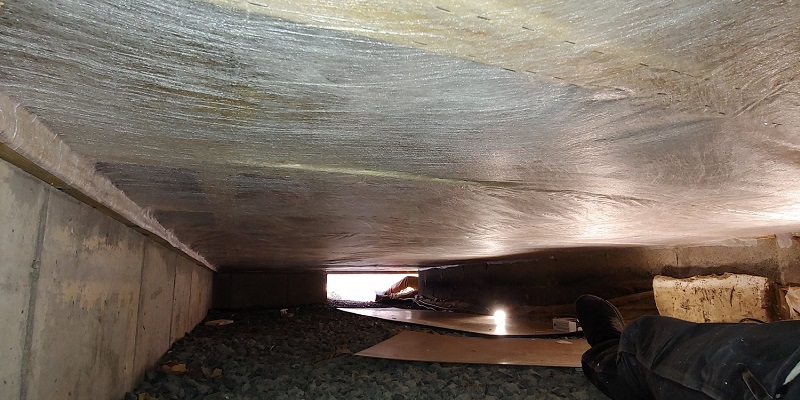
Recommendations for Effective Moisture Management and Insulation
Install a Vapor Barrier: To protect fiberglass insulation for crawl space from moisture, it is crucial to install a vapor barrier on the dirt floor. The vapor barrier should cover the entire surface and extend up the foundation walls to prevent moisture from entering the crawl space. This barrier helps to keep the insulation dry and maintain its performance over time.
Ensure Proper Ventilation: Adequate ventilation is important to prevent moisture buildup in the crawl space. While fiberglass insulation for crawl space can help with thermal performance, proper ventilation ensures that any residual moisture is effectively managed. Installing vents or a dehumidifier can help maintain a dry environment.
Regular Inspections and Maintenance: Regular inspections of the crawl space and insulation are essential for identifying and addressing any issues early. Check for signs of moisture damage, mold growth, or insulation displacement. Prompt maintenance and repairs can help prolong the life of the insulation and maintain its effectiveness.
Professional Installation: While DIY installation of fiberglass insulation for crawl space is possible, professional installation ensures that the insulation, including loose fill fiberglass insulation, is properly installed and meets all building codes. This approach guarantees optimal performance and energy efficiency in your home.Professionals can also assess the crawl space for any additional requirements, such as moisture control solutions or structural repairs.
Consider Insulation Upgrades: If fiberglass insulation for crawl space does not meet your performance needs, consider upgrading to other insulation types that offer better moisture resistance or higher R-values. Foam board or spray foam insulation may provide enhanced performance and durability for challenging crawl space conditions.
Fiberglass Insulation in Sub Box: Pros, Cons, and Installation Tips
The Pros and Cons of Fiberglass Insulation for Crawl Space
The Benefits of Fiberglass Insulation for Crawl Space
Fiberglass insulation for crawl space offers numerous advantages that make it a popular choice for homeowners and builders. Understanding these benefits can help in deciding whether this insulation type is suitable for your specific needs.
Cost-Effectiveness and Availability
One of the most significant advantages of fiberglass insulation for crawl space is its cost-effectiveness. Fiberglass is generally less expensive compared to other types of insulation, such as spray foam or rigid foam boards. This affordability makes it an attractive option for many homeowners looking to improve their home’s energy efficiency without breaking the bank. The material’s wide availability also means that it can be easily sourced from most building supply stores or directly from manufacturers like GangLong Fiberglass.
Ease of Installation
Fiberglass insulation for crawl space is known for its relatively straightforward installation process. It typically comes in batts or rolls that can be easily cut to fit between floor joists or around ductwork. This ease of installation reduces labor costs and time compared to more complex insulation types. Many homeowners and DIY enthusiasts can handle the installation themselves with basic tools and safety equipment. The flexibility of fiberglass batts allows them to conform to various shapes and sizes, making them versatile for different crawl space configurations.
Thermal Performance
Fiberglass insulation provides excellent thermal performance, which is crucial for maintaining comfortable temperatures within the home. The material’s R-value, which measures its thermal resistance, ensures that it effectively reduces heat transfer between the crawl space and the living areas above. Properly installed fiberglass insulation for crawl space helps keep floors warmer in winter and cooler in summer, contributing to overall energy savings. This thermal resistance can also lead to reduced heating and cooling costs over time, making it a beneficial investment for energy efficiency.
The Drawbacks of Fiberglass Insulation for Crawl Space
While fiberglass insulation for crawl space has several benefits, it also comes with certain drawbacks that need to be considered. Understanding these potential issues is important for making an informed decision about insulation options.
Potential Moisture Issues
One of the main drawbacks of fiberglass insulation for crawl space is its susceptibility to moisture problems. Fiberglass does not absorb moisture but can trap it within its fibers if not properly installed. In damp or poorly ventilated crawl spaces, this trapped moisture can lead to a reduction in insulation performance and create a breeding ground for mold and mildew. To mitigate this issue, it is essential to ensure that the crawl space is properly ventilated and to use vapor barriers where necessary. Regular inspection and maintenance can help address any moisture problems before they become severe.
Mold Growth
The presence of moisture can also lead to mold growth on fiberglass insulation. While fiberglass itself is not a food source for mold, it can provide a favorable environment for mold growth if moisture is present. Mold can compromise the integrity of the insulation and potentially affect indoor air quality. If mold growth is detected, it is crucial to address both the mold issue and the underlying moisture problem. In some cases, replacing affected insulation with new fiberglass batts from GangLong Fiberglass may be necessary to ensure that the insulation remains effective and safe.
Maintenance Challenges
Fiberglass insulation for crawl space can present maintenance challenges over time. Unlike some other insulation types, fiberglass batts may require periodic checks to ensure they remain in good condition. Damage to the insulation, such as from pests or physical wear and tear, can reduce its effectiveness and may require replacement or repair. Regular inspections and prompt repairs can help maintain the insulation’s performance and extend its lifespan.
What is Fiberglass Insulation for Crawl Space?
Fiberglass insulation for crawl space is a highly effective method of insulating crawl spaces to improve a home’s energy efficiency, comfort, and protection from moisture. Crawl spaces, often found underneath houses, are notorious for being areas where cold air, moisture, and even pests can accumulate. Without proper insulation, these crawl spaces can contribute to heat loss in the winter and overheating in the summer, leading to increased energy bills and discomfort in your living space.
Fiberglass insulation is a popular choice for crawl spaces because it provides excellent thermal protection at an affordable cost. Made from tiny strands of glass fibers, fiberglass traps air pockets that help slow down the transfer of heat, keeping the temperature inside your home more stable. This material is available in batts or rolls and is designed to fit between floor joists in the crawl space, making installation straightforward.
The decision to install fiberglass insulation in your crawl space can lead to significant energy savings, better moisture control, and an overall increase in home comfort. At GangLong Fiberglass, we offer high-quality fiberglass insulation solutions tailored to meet the specific needs of crawl space insulation projects, ensuring long-lasting protection for your home.
The Key of Installing Fiberglass Insulation for Crawl Space
When installing fiberglass insulation for crawl space, there are several important factors to consider. The process involves more than simply laying insulation; it requires proper preparation, installation, and post-installation care to ensure the insulation performs optimally. Here’s a detailed breakdown of the steps involved in installing fiberglass insulation for crawl space:
1. Preparing the Crawl Space:
Before installing fiberglass insulation, it’s important to prepare the crawl space. This includes cleaning out debris, sealing any holes or gaps where air or moisture could enter, and ensuring that there is adequate ventilation. If your crawl space has high moisture levels, installing a vapor barrier on the ground is crucial. This barrier helps prevent moisture from rising into the insulation, which could lead to mold growth and reduce the insulation’s effectiveness.
2. Choosing the Right Type of Insulation:
Fiberglass insulation comes in different forms, such as batts, rolls, and loose-fill. For crawl space applications, fiberglass batts or rolls are typically used. These are cut to fit between the floor joists, creating a snug fit that minimizes gaps and maximizes thermal protection. At GangLong Fiberglass, we provide a range of fiberglass insulation products that are pre-cut to standard sizes, ensuring a perfect fit for your crawl space needs.
3. Installation Techniques:
The insulation should be installed with the vapor barrier facing up toward the heated area of the home, and the batts should fit snugly between the floor joists without being compressed. Compressing the insulation reduces its effectiveness by limiting the air pockets that provide insulation. When placing the insulation, avoid blocking any ventilation points, as these are necessary for maintaining airflow and controlling moisture levels. Once the insulation is in place, it may be necessary to secure it with wire supports or fasteners to keep it from sagging over time.
4. Post-Installation Inspection:
After installation, it’s essential to inspect the crawl space regularly to ensure the insulation remains in place and that there are no signs of moisture infiltration or pest activity. Over time, insulation can settle or become dislodged, reducing its effectiveness. Periodic inspections can help identify any issues early and allow for quick repairs.
Benefits of Fiberglass Insulation for Crawl Space
There are several significant benefits to using fiberglass insulation for crawl space, making it an excellent choice for homeowners who want to improve their home’s energy efficiency and comfort.
1. Energy Savings:
One of the most compelling reasons to install fiberglass insulation in your crawl space is the potential for energy savings. By reducing heat loss in the winter and heat gain in the summer, fiberglass insulation helps stabilize the temperature inside your home, reducing the workload on your heating and cooling systems. This, in turn, can lower your energy bills significantly over time.
2. Moisture Control:
Crawl spaces are particularly vulnerable to moisture buildup, which can lead to mold growth, wood rot, and structural damage. Properly installed fiberglass insulation, combined with a vapor barrier, helps control moisture levels by preventing dampness from rising into the home. This not only protects the integrity of your home but also improves indoor air quality by reducing the presence of mold and mildew.
3. Improved Comfort:
Homes with poorly insulated crawl spaces often suffer from uneven temperatures, with floors that feel cold in the winter and too warm in the summer. Fiberglass insulation helps maintain a more consistent temperature throughout your home, making your living spaces more comfortable year-round.
4. Soundproofing:
Another benefit of fiberglass insulation is its ability to absorb sound. By installing fiberglass insulation in your crawl space, you can reduce noise from outside sources, such as traffic or nearby construction, creating a quieter indoor environment.
5. Pest Prevention:
Properly installed fiberglass insulation can also act as a barrier to pests, preventing rodents and insects from entering your crawl space. Sealing gaps and installing insulation reduces the likelihood of infestations, which can cause damage to your home’s structure and insulation materials.
Effective Ways to Cover Exposed Fiberglass Insulation at Home
How about Choosing the Right Thickness for Fiberglass Insulation for Crawl Space?
Choosing the right thickness of fiberglass insulation for crawl space is crucial for ensuring optimal performance. The thickness of the insulation, measured in R-value, determines its ability to resist heat transfer. The higher the R-value, the greater the insulation’s effectiveness.
For crawl spaces, the recommended R-value typically falls between R-19 and R-30, depending on your climate and local building codes. In colder climates, a higher R-value may be necessary to provide adequate thermal protection, while in milder climates, a lower R-value may suffice.
When selecting the thickness of your fiberglass insulation, it’s important to consider the space between your floor joists. Standard joist spacing in homes is usually 16 or 24 inches, and fiberglass batts are available in widths designed to fit these spaces. At GangLong Fiberglass, we offer a variety of insulation products in different thicknesses and R-values, ensuring that you can find the right solution for your crawl space insulation project.
Cost Considerations for Fiberglass Insulation for Crawl Space
When planning to install fiberglass insulation for crawl space, understanding the associated costs is important for budgeting effectively. Several factors can influence the overall cost of the project, including the type of insulation, installation complexity, and additional materials required.
1. Type of Fiberglass Insulation:
Fiberglass insulation is available in different forms, such as batts, rolls, and loose-fill. The cost of these materials can vary, with batts and rolls generally being more affordable than loose-fill. Pre-cut batts designed for specific crawl space applications, like those offered by GangLong Fiberglass, can reduce installation time and labor costs, making them a cost-effective choice.
2. Installation Complexity:
The complexity of the installation can also affect the cost. For example, if your crawl space has irregularly spaced floor joists or significant moisture issues, the installation process may require additional steps, such as sealing gaps or installing a vapor barrier. Crawl spaces with limited access may also require more labor, increasing the overall cost.
3. Additional Materials:
In addition to the fiberglass insulation itself, other materials may be required for the installation, such as vapor barriers, wire supports, and fasteners. These materials can add to the total cost of the project, so it’s important to factor them into your budget.
4. Labor Costs:
If you choose to hire a professional installer, labor costs will be a significant part of the overall expense. Professional installation can ensure that the insulation is installed correctly and efficiently, reducing the likelihood of future issues. However, for those looking to save money, installing fiberglass insulation as a DIY project is a viable option, especially with the straightforward installation process of fiberglass batts.
5. Long-Term Savings:
While there is an initial cost associated with installing fiberglass insulation in your crawl space, it’s important to consider the long-term savings. By improving your home’s energy efficiency, you can reduce your heating and cooling costs, leading to significant savings over time. The investment in insulation can pay for itself through reduced energy bills, improved home comfort, and increased home value.
At GangLong Fiberglass, we provide a range of fiberglass insulation products that cater to different budgets and project needs. Whether you’re looking for standard batts or custom insulation solutions, we offer cost-effective options that deliver long-term value.
DIY Fiberglass Insulation for Crawl Space: A Step-by-Step Guide
For homeowners looking to save on installation costs, installing fiberglass insulation in a crawl space can be a manageable DIY project. Here’s a step-by-step guide to help you get started:
1. Gather Materials and Tools:
Before starting, gather all the necessary materials, including fiberglass insulation batts, a vapor barrier, wire supports or fasteners, a utility knife, a dust mask, gloves, and safety goggles. Having the right tools on hand will make the installation process more efficient.
2. Prepare the Crawl Space:
Start by cleaning out the crawl space, removing any debris, and sealing gaps or cracks in the foundation where air or moisture could enter. If moisture is a concern, lay down a vapor barrier on the ground to prevent dampness from rising into the insulation.
3. Install the Insulation:
Measure and cut the fiberglass insulation batts to fit between the floor joists. Place the batts with the vapor barrier facing up toward the living space, ensuring a snug fit. Use wire supports or fasteners to secure the insulation in place and prevent it from sagging over time.
4. Inspect and Maintain:
After installation, periodically inspect the crawl space to ensure the insulation remains in good condition. Look for signs of moisture or displacement and make any necessary repairs.
How CertainTeed Fiberglass Insulation Improves Energy Efficiency
FAQs about Fiberglass Insulation for Crawl Space
Foam board insulation can be better than fiberglass insulation for crawl spaces, especially in areas with moisture concerns. Foam boards, made from materials like expanded polystyrene (EPS), extruded polystyrene (XPS), or polyisocyanurate, offer higher R-values per inch and are resistant to moisture absorption. This resistance makes them less susceptible to mold and mildew growth compared to fiberglass, which can absorb moisture and lose its insulating properties when wet. Foam boards also provide a continuous layer of insulation and can act as a vapor barrier when seams are properly sealed, enhancing energy efficiency by reducing air infiltration.
On the other hand, fiberglass insulation is more affordable and easier for DIY installation but may not perform as well in damp environments. In crawl spaces where moisture control is a significant concern, closed-cell spray foam insulation might also be considered due to its superior moisture resistance and air-sealing capabilities, though it comes at a higher cost. Ultimately, the choice between foam board and fiberglass insulation depends on factors like your climate, moisture levels in the crawl space, budget, and specific insulation goals. Consulting with a professional can provide guidance tailored to your situation, ensuring you select the most effective insulation material for your crawl space.
Yes, insulating your crawl space is generally worth the investment. Proper crawl space insulation can lead to significant energy savings by reducing heat loss in the winter and heat gain in the summer, resulting in lower heating and cooling costs. It also enhances indoor comfort by stabilizing floor temperatures and reducing drafts coming from below. Additionally, insulation can help prevent moisture problems that lead to mold growth, wood rot, and structural damage, thereby protecting your home’s integrity and potentially avoiding costly repairs. A well-insulated crawl space can also improve indoor air quality by acting as a barrier against soil gases like radon and reducing the entry of allergens and pollutants. While there is an upfront cost associated with insulating a crawl space, the long-term benefits in energy efficiency, comfort, and home preservation often outweigh the initial expense. Moreover, an insulated crawl space can increase your property’s resale value, making it a worthwhile investment for homeowners planning to sell in the future.
Yes, you can use fiberglass insulation in a crawl space. Fiberglass insulation is one of the most common materials used for insulating crawl spaces due to its affordability and ease of installation. It effectively reduces heat loss and can improve the overall energy efficiency of your home. When installing fiberglass insulation in a crawl space, it’s important to choose the right type—either faced or unfaced batts—depending on moisture levels and local building codes. The insulation is typically installed between the floor joists, with the vapor barrier facing up toward the heated space. Proper installation is crucial to prevent issues like moisture accumulation, mold growth, or pest infestations. It’s also essential to ensure that the crawl space is well-ventilated or properly encapsulated to control humidity levels. In areas with high moisture, additional measures like installing a vapor barrier on the ground or using moisture-resistant insulation materials may be necessary. Consulting with a professional installer can help you determine the best approach for your specific situation.
Yes, fiberglass insulation can be used in a crawl space, but it must be installed correctly to be effective. It’s commonly used to insulate the crawl space’s subfloor, particularly in vented crawl spaces. However, fiberglass batts are prone to absorbing moisture in humid environments, which can lead to mold growth and sagging. For this reason, it’s important to use faced fiberglass batts with a vapor barrier installed toward the warm side. If the crawl space has issues with moisture, consider sealing it first and using alternative insulation like spray foam or rigid foam boards, which are better at repelling moisture.
The best insulation for a crawl space depends on whether it is vented or unvented. For vented crawl spaces, fiberglass batt insulation is often used to insulate the subfloor. However, for unvented or sealed crawl spaces, closed-cell spray foam or rigid foam boards are preferred. These materials provide excellent moisture resistance, air sealing, and thermal performance. Reflective insulation is another option for improving energy efficiency in crawl spaces with radiant heat concerns.
R19 insulation is often used for insulating crawl spaces, particularly in regions with mild climates. It provides a good balance of thermal resistance for insulating the subfloor in vented crawl spaces. However, for unvented crawl spaces or regions with colder climates, a higher R-value like R30 may be more effective. Always consult local building codes and climate recommendations when choosing insulation.
R30 insulation is a good choice for crawl spaces in colder climates. It offers a higher R-value, which is ideal for subfloor insulation in vented crawl spaces. For unvented crawl spaces, R30 may be overkill unless local building codes or specific energy-efficiency goals require it. Combining R30 with proper moisture control is essential for long-term effectiveness.
R13 insulation is commonly used for walls, floors, and ceilings in areas with milder climates. In crawl spaces, R13 can be suitable for subfloor insulation in regions where extreme thermal protection is not necessary. However, for colder climates, a higher R-value like R19 or R30 is recommended.
The cost to insulate a crawl space depends on the insulation type, size of the crawl space, and labor costs. Fiberglass insulation typically costs $0.60–$1.30 per square foot for materials alone. Including labor, the total cost ranges from $1.50–$3.50 per square foot. Spray foam and rigid foam boards cost more, averaging $3.50–$7.00 per square foot.
Crawl space insulation costs vary widely, with an average range of $500–$4,500 for most residential projects. Smaller projects using fiberglass may cost as little as $500–$1,500, while larger or more complex projects using spray foam can exceed $3,000.
R13 and R15 insulation differ slightly in thermal resistance. R15 has a higher R-value, making it more effective at reducing heat transfer. Both are suitable for walls and floors in mild climates, but R15 provides better energy efficiency and may be required in areas with stricter building codes. For crawl spaces, R15 is a better choice for slightly improved insulation performance.

As the editor of GangLong Fiberglass, I have years of experience and in-depth research, focusing on cable tray products, fiberglass solutions, and grille systems. I incorporate years of industry insights and practical experience into every content, committed to promoting the progress of the industry. At GangLong Fiberglass, my commitment is reflected in every product, from innovative cable trays to durable fiberglass solutions and sturdy grille systems. As an authoritative voice in the industry, my goal is to provide valuable information to professionals and businesses and promote forward-looking solutions.

